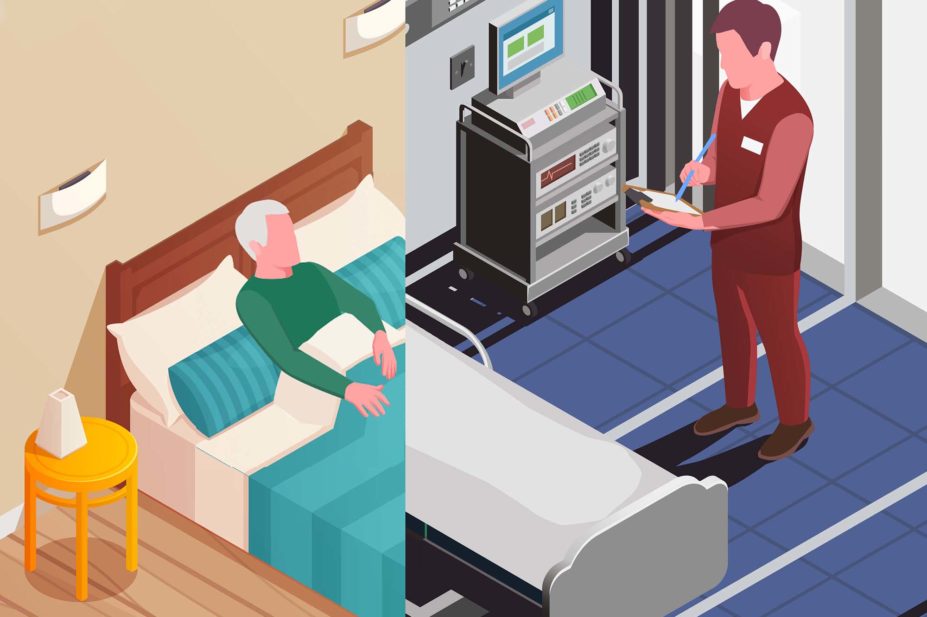
Mclean/Shutterstock
During the COVID-19 pandemic, many virtual wards were set up and run by primary or secondary care services across the country to monitor COVID-positive patients at home. However, this is part of a service that has been established for some time in our trust, known as ‘Hospital at Home’. According to NHS England and NHS improvement, the definition of ‘Hospital at Home’ is a virtual ward that may also require in-person care (e.g to deliver a care assessment or acute level interventions, such as IV therapy).
I joined the Hospital at Home service in Oxford in 2016, around a year after its initial set up. Back then, its primary aim was to enable patients to be discharged earlier in their hospital journey, perhaps needing a few more days of IV antibiotics. Over the past five years, the service has grown and now sees around 150 new patients per month, aiming to treat them in their usual place of residence (including home, residential or nursing home and even hotel), providing an alternative to admission to hospital.
The service reviews a whole range of medical patients, similar to what you might expect to see on a general medical or geratology ward. This can include decompensated heart failure; chest, urine and skin and soft tissue infections; acute kidney injury; and frailty syndromes. Although the phrase ‘virtual ward’ has been coined for out-of-hospital treatment during the pandemic, the treatment they receive is not virtual. Patients may expect home visits from the whole multidisciplinary team (MDT), sometimes several times a day for assessment or treatment.
For many patients, spending time in hospital can be daunting. This was particularly highlighted during the COVID-19 pandemic when many wards have not allowed visitors and some patients preferred to stay away from the hospital because they were shielding. Patient feedback suggests that patients appreciate eating their usual food, wearing their normal clothes and spending time with their family and friends while recovering from illness. We have found that for some patients with cognitive impairment, maintaining a familiar environment with carers who know the patient well can help improve physical recovery. There is also evidence emerging that it may reduce the likelihood of developing delirium.
Being in the patient’s home enables me to see how they are managing their medicines
As a pharmacist, I spend my time doing traditional pharmacy tasks, such as performing medicines reconciliations and clinically reviewing and supplying prescriptions. The challenge is that these patients are not physically in hospital and, for many patients, I travel out to their homes to visit them. Being in the patient’s home enables me to see how they are managing their medicines, and on several occasions I have found months of unopened medicines in a cupboard. More critically, I spend a lot of time considering how we can administer medicines to patients at home to avoid admitting them into hospital. The main considerations when deciding on treatment plans include:
- The number of times a day a medicine needs to be administered — for example, once-a-day medicines require less nursing visits than three times a day medicines;
- Use of pumps for administration — we use elastomeric pumps for continuous infusions of some antibiotics that would otherwise require three or four times a day administrations, and have pumps available to be able to administer high doses of furosemide safely;
- Patient environment — can medicines be self-administered or be monitored by nursing home staff, for example? Do they have access to running water for handwashing and a phone for emergencies?
- Risk of anaphylaxis — is the patient at risk of having a reaction? Does the visiting clinician need to carry additional medicines or an antiepileptic drug?
- Monitoring — does the medicine require continuous monitoring or repeat blood tests at a certain time point?
Considering these points, I often work with the medical team to refine plans to make them suitable for administration and monitoring at home. Each week, all our patients are discussed in a virtual MDT with specialists to ensure that they are receiving optimal treatment.
I’m also a trainee advanced clinical practitioner, so my visits are not just to review medicines. I’m able to take bloods, give IV medicines and I’m currently learning how to perform point-of-care ultrasound. The challenge of working in patients’ homes is that all members of the team need to be multi-skilled in order to provide the holistic care that we strive to deliver, as the full MDT is not present in the patient’s home each day.
NHS X, the government’s health technology unit, is encouraging the expansion of existing virtual wards. All integrated care systems are now being encouraged by NHS England to establish a Hospital at Home virtual ward to support alternatives to admission for patients with frailty systems. This promotes patient choice around where they wish to receive their treatment, where being at home is a viable alternative to acute hospital admission. Bearing all this in mind, expect to see a hospital at home service appearing in your area soon.
Sophie McGlen, lead pharmacist ambulatory care, Oxford University Hospitals NHS Trust


